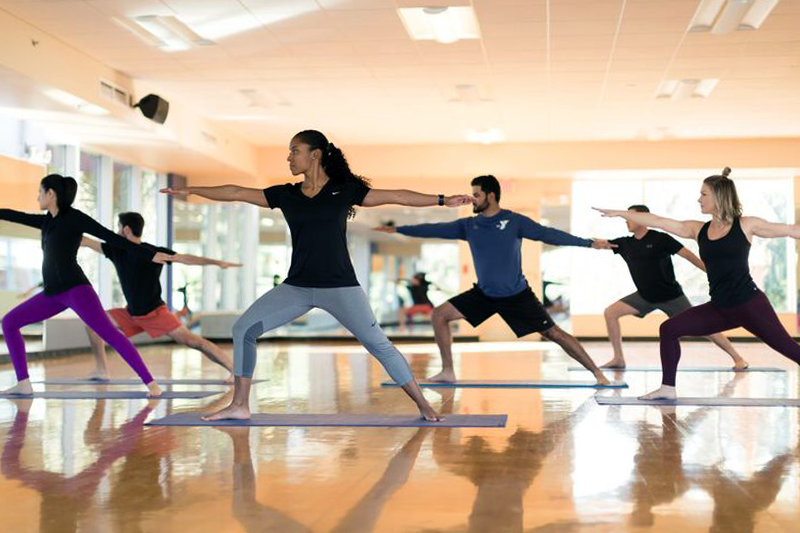If you're thinking about adding yoga class to your fitness routine, you’re not alone! You might already have a wellness goal in mind like gaining muscle, losing weight, or becoming more mindful of your mental health. However, because there are several types of yoga, it can sometimes be a bit overwhelming to get started. Despite how different some types can be, any yoga class is great for helping you improve strength and coordination, relieve physical tension, and achieve a more peaceful mental state by relaxing your mind. Read our blog to find out about the positive effects yoga has, and learn about some of the classes found at the Y!
Yoga's Effects on the Spirit, Mind, and Body
At its core, yoga is all about being present in whatever moment you're in and finding a sense of inner peace. Oftentimes, many people even use the stillness during meditation as an act of worship before or after a period of self-reflection. While you may think yoga is tied to one particular religion or culture, the ultimate goal of any type of yoga class is to allow you to feel like you've got a stronger sense of connection between yourself, your spirit, and the world around you.
You might also believe dusting off your yoga mat is only necessary when you're feeling more anxious than usual. However, you don't have to deal with added stress in order to take a class. Mentally, yoga has scientifically been shown to help promote overall clarity and calmness by lowering cortisol, the stress hormone. In fact, regular practice has also been shown to help people learn how to center themselves and better their concentration skills.
While originates in India and began more than 5,000 years ago the physical, mental, and spiritual benefits have remained the same. Incorporating yoga into your daily or weekly routine will positively affect your body by:
- Improving strength and flexibility, especially within your core and muscles surrounding your spine;
- Lowering inflammation within your body, relieving chronic fatigue;
- Boosting your immune and respiratory systems, giving you more stamina;
- Strengthening your cardio and circulatory systems, helping improve energy;
- Increasing your metabolism, which can help contribute to weight loss; and
- Helping proactively prevent bodily injuries.
Types of Yoga at the Y
Explore some of the yoga classes dedicated to building long-lasting benefits such as tranquility, flexibility, and relationships. To read our full list of yoga class descriptions, click here. Please note, each type of yoga class may not be available at every family center, so we encourage you to check your family center’s schedule to see what’s offered at your YMCA!
- Basic Yoga: Fundamental introduction to yoga. This class will focus on the most common yoga postures, breathing techniques, stretching, toning, and relaxation. Enjoy a few standing and balancing poses followed by floor stretches and guided relaxation.
- Chair Yoga: Chair yoga is a suitable practice for students unable to participate in traditional yoga classes due to limitations. Chair yoga offers a practical alternative, as it deepens flexibility and strengthens personal body awareness. Participants will move through yoga postures, focus on breathing techniques, meditation, and ways of relaxation, with the aid of a chair.
- Flow/Vinyasa Yoga: Also known as Vinyasa yoga, it focuses on the breath to guide movement through smooth transitions and sequences, usually including sun salutations. Vinyasa features a mixture of strengthening, standing and balancing poses, basic backbends, and seated floor work. Expect to move at a slow to moderate pace.
- Hatha (Traditional) Yoga: Focus on one pose at a time with rest in between. Moving with deep awareness and mindfulness, ease into a variety of postures, holding and linking these postures with the breath to help you build a foundation. Classes may also include some sun salutations, which is the sequencing of movements paired with the breath.
- Power Yoga: Power yoga provides an aerobic, challenging class that incorporates the athleticism of Ashtanga and flow of Vinyasa. Expect a moderate to vigorous pace, focusing on strength, stability, stretching, toning, and increasing flexibility with options to go physically deeper into poses.
- Yin Yoga: Yin yoga is a quiet practice suitable for all levels. Through the practice of long-held postures (typically 2–5 minutes) targeting the connective tissues. Yin yoga invites you to slow down and create space for stillness while nourishing joints, ligaments, tendons, and fascia.
- Yoga Strength: Improve strength, flexibility, and balance with a blend of yoga poses and Pilates exercises. Hand weights are used and cardio intervals are included. Increase your stamina and concentration and have fun in the process.
- Yogilates: Enjoy a method of exercise that integrates the core strengthening and alignment principles of Pilates with the practice of Hatha yoga.
